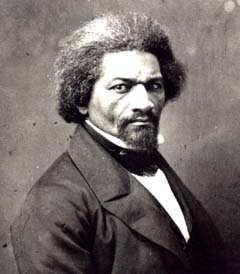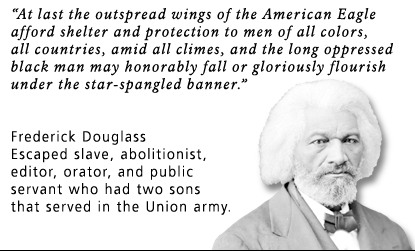|
Frederick Douglass
Frederick
Douglass Overview
| Frederick Douglass (c. 1866) |

|
| Frederick Douglass (c. 1866) |
Frederick Douglass stood at the podium, trembling with nervousness. Before him sat
abolitionists who had traveled to the Massachusetts island of Nantucket. Only 23 years old, Douglass overcame his nervousness
and gave a stirring, eloquent speech about his life as a slave. Douglass would continue to give speeches for the rest of his
life and would become a leading spokesperson for the abolition of slavery and for racial equality.
The son of
a slave woman and an unknown white man, "Frederick Augustus Washington Bailey" was born in February of 1818 on Maryland's
eastern shore. He spent his early years with his grandparents and with an aunt, seeing his mother only four or five times
before her death when he was seven. (All Douglass knew of his father was that he was white.) During this time he was exposed
to the degradations of slavery, witnessing firsthand brutal whippings and spending much time cold and hungry. When he was
eight he was sent to Baltimore to live with a ship carpenter named Hugh Auld. There he learned to read and first heard the
words abolition and abolitionists. "Going to live at Baltimore," Douglass would later say, "laid the foundation, and opened
the gateway, to all my subsequent prosperity."
Douglass spent seven relatively comfortable years in Baltimore before
being sent back to the country, where he was hired out to a farm run by a notoriously brutal "slavebreaker" named Edward Covey.
And the treatment he received was indeed brutal. Whipped daily and barely fed, Douglass was "broken in body, soul, and spirit."
On
January 1, 1836, Douglass made a resolution that he would be free by the end of the year. He planned an escape. But early
in April, he was jailed after his plan was discovered. Two years later, while living in Baltimore and working at a shipyard,
Douglass would finally realize his dream: he fled the city on September 3, 1838. Travelling by train, then steamboat, then
train, he arrived in New York City the following day. Several weeks later, he had settled in New Bedford, Massachusetts, living
with his newlywed bride (whom he met in Baltimore and married in New York) under his new name, Frederick Douglass.
Always
striving to educate himself, Douglass continued his reading. He joined various organizations in New Bedford, including a black
church. He attended Abolitionists' meetings. He subscribed to William Lloyd Garrison's weekly journal, the Liberator.
In 1841, he saw Garrison speak at the Bristol Anti-Slavery Society's annual meeting. Douglass was inspired by the speaker,
later stating, "No face and form ever impressed me with such sentiments [the hatred of slavery] as did those of William Lloyd
Garrison." Garrison, too, was impressed with Douglass, mentioning him in the Liberator. Several days later Douglass
gave his speech at the Massachusetts Anti-Slavery Society's annual convention in Nantucket-- the speech described at the top
of this page. Of the speech, one correspondent reported, "Flinty hearts were pierced, and cold ones melted by his eloquence."
Before leaving the island, Douglass was asked to become a lecturer for the Society for three years. It was the launch of a
career that would continue throughout Douglass' long life.
In 1845, despite apprehensions that the information might
endanger his freedom, Douglass published his autobiography, Narrative of the Life of Frederick Douglass, an American Slave,
Written By Himself. Three years later, after a speaking tour of England, Ireland, and Scotland, Douglass published the
first issue of the North Star, a four-page weekly, out of Rochester, New York.

Ever since he first met Garrison in 1841, the white abolitionist leader had been Douglass' mentor. But the views of Garrison and Douglass ultimately diverged. Garrison represented the radical end
of the abolitionist spectrum. He denounced churches, political parties, even voting. He believed in the dissolution of the
Union. He also believed that the U.S. Constitution was a pro-slavery document. After his tour of Europe and the establishment
of his paper, Douglass' views began to change; he was becoming more of an independent thinker, more pragmatic. In 1851,
Douglass announced at a meeting in Syracuse, New York, that he did not assume the Constitution was a pro-slavery document,
and that it could even "be wielded in behalf of emancipation," especially where the federal government had exclusive jurisdiction.
Douglass also did not advocate the dissolution of the Union, since it would isolate slaves in the South. This led to a bitter
dispute between Garrison and Douglass that, despite the efforts of others such as Harriet Beecher Stowe to reconcile the two,
would last into the Civil War.
Frederick Douglass would continue his active
involvement to better the lives of African Americans. He conferred with Abraham Lincoln during the Civil War and recruited
northern blacks for the Union Army. After the War, he fought for the rights of women and African Americans alike. "He
[Frederick Douglass] is an African American hero... he is an American hero."
Recommended Reading: The Radical and the Republican: Frederick Douglass, Abraham Lincoln, and the Triumph of Antislavery
Politics. Publishers Weekly: The perennial tension between principle and pragmatism in politics frames this engaging
account of two Civil War Era icons. Historian Oakes (Slavery and Freedom) charts the course by which Douglass and Lincoln,
initially far apart on the antislavery spectrum, gravitated toward each other. Lincoln began as a moderate who advocated banning
slavery in the territories while tolerating it in the South, rejected social equality for blacks and wanted to send freedmen
overseas—and wound up abolishing slavery outright and increasingly supporting black voting rights. Conversely, the abolitionist
firebrand Douglass moved from an impatient, self-marginalizing moral rectitude to a recognition of compromise, coalition building
and incremental goals as necessary steps forward in a democracy. Continued below...
Douglass's
views on race were essentially modern; the book is really a study through his eyes of the more complex figure of Lincoln.
Oakes lucidly explores how political realities and military necessity influenced Lincoln's
tortuous path to emancipation, and asks whether his often bigoted pronouncements represented real conviction or strategic
concessions to white racism. As Douglass shifts from denouncing Lincoln's foot-dragging to
revering his achievements, Oakes vividly conveys both the immense distance America
traveled to arrive at a more enlightened place and the fraught politics that brought it there. AWARDED FIVE STARS by americancivilwarhistory.org
Related Reading:
Recommended Reading: The Narrative of the Life of Frederick Douglass, An American Slave
(Barnes & Noble Classics Series). Description:
No book except perhaps Uncle Tom’s Cabin had as powerful an impact on the abolitionist movement as Narrative of the
Life of Frederick Douglass. But while Stowe wrote about imaginary characters, Douglass’s book is a record of his own
remarkable life. Born a slave in 1818 on a plantation in Maryland,
Douglass taught himself to read and write. In 1845, seven years after escaping to the North, he published Narrative, the first
of three autobiographies. Continued below...
This book calmly but dramatically
recounts the horrors and the accomplishments of his early years—the daily, casual brutality of the white masters; his
painful efforts to educate himself; his decision to find freedom or die; and his harrowing but successful escape. An astonishing
orator and a skillful writer, Douglass became a newspaper editor, a political activist, and an eloquent spokesperson for the
civil rights of African Americans. He lived through the Civil War, the end of slavery, and the beginning of segregation. He
was celebrated internationally as the leading black intellectual of his day...and his story still resonates. Narrative of
Frederick Douglass, An American Slave, by Frederick Douglass, is part of the Barnes & Noble Classics series, which offers
quality editions at affordable prices to the student and the general reader, including new scholarship, thoughtful design,
and pages of carefully crafted extras. Here are some of the remarkable features of Barnes & Noble Classics: New introductions
commissioned from today's top writers and scholars; Biographies of the authors; Chronologies of contemporary historical, biographical,
and cultural events; Footnotes and endnotes; Selective discussions of imitations, parodies, poems, books, plays, paintings,
operas, statuary, and films inspired by the work; Comments by other famous authors; Study questions to challenge the reader's
viewpoints and expectations; Bibliographies for further reading; Indices & Glossaries, when appropriate. All editions
are beautifully designed and are printed to superior specifications; some include illustrations of historical interest. Barnes
& Noble Classics pulls together a constellation of influences—biographical, historical, and literary—to enrich
each reader's understanding of these enduring works. AWARDED 5 STARS by americancivilwarhistory.org
Recommended Reading: Frederick
Douglass : Autobiographies : Narrative of the Life of Frederick Douglass, an American Slave / My Bondage and My Freedom /
Life and Times of Frederick Douglass (Library of America)
Hardcover: 1100 pages).
Review From Library Journal: Douglass (1818-95), a former slave, rose to become an abolitionist, writer, and orator. In this
collection of his autobiographical writings, edited by Gates (humanities, Harvard
Univ.), he gives an extensive overview of his life. The work includes
Narrative of the Life of Frederick Douglass, an American Slave (1845); My Bondage and My Freedom (1855); and Life and Times
of Frederick Douglass (1881). Continued below...
In Narrative,
Douglass comments on his birth, his parentage, his two masters, and the brutality of slavery he witnessed. In Bondage, he
reflects on his childhood, life on the plantation, and his runaway plot. Life and Times concludes the trilogy: it covers his
early life as a slave, his escape from bondage, and his connection with the antislavery movement. This massive volume containing
Douglass's seminal works is highly recommended for black history collections.
Recommended Reading: The
Life and Times of Frederick Douglass (Dover Value Editions). Description: Raised as a plantation slave, Douglass
went on to become a writer, orator, and major participant in the struggle for African-American freedom and equality. In this
engrossing narrative he recounts early years of abuse; his dramatic escape to the North and eventual freedom, abolitionist
campaigns, and his crusade for full civil rights for former slaves.
Recommended Reading: Douglass:
Autobiographies (Library of America College Editions). Description: Frederick Douglass, born a slave, educated himself, escaped, and made himself one of the greatest leaders in
American history. His brilliant anti-slavery speeches were so fiercely intelligent, and so startlingly eloquent, that many
people didn't believe he had been a slave. To prove them wrong, Douglass decided to write his own story. Continued below...
His autobiographical narratives stunned the world, and have shocked, moved, and inspired readers ever since.
Here, complete for the first time in one authoritative volume, are the three powerful and gripping stories, now recognized
as classics of American writing. Fascinating firsthand accounts of slavery and abolitionism, John Brown and Abraham Lincoln,
Civil War, Reconstruction, and the emerging struggle for civil rights, they are above all the inspiring story of a self-made
American: a slave who became adviser to the President, minister to Haiti, and the most influential black
American of the nineteenth century.
Our Frederick Douglass Homepage discusses the following: Abolitionist
Frederick Douglass and the Antislavery Movement History, Abolitionist Leader Frederick Douglass Accomplishments, Achievements,
and Final Results.
|

